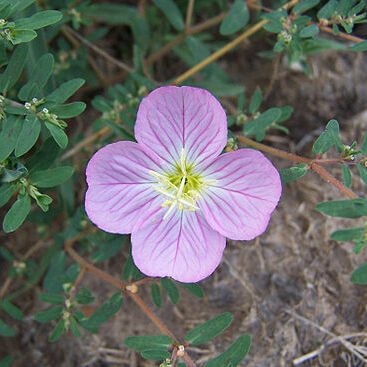Fls 4-merous, solitary in the axils or forming a terminal raceme or spike, commonly vespertine and ephemeral, but matutinal or diurnal and lasting several days in spp. 13–17; hypanthium usually slenderly tubular and prolonged well beyond the ovary (at least 3 mm in all but one of our spp.), deciduous from the fr; sep at first connate, often with terminal or subterminal appendages, splitting at anthesis and reflexed; pet in most of our spp. yellow, in two white or pink, often large and showy; stamens 8, equal or alternately unequal; anthers versatile (sometimes obscurely so in small fls); sporogenous tissue continuous in each microsporangium; ovary 4-locular; ovules numerous; style ± elongate; stigma with 4 slender lobes stigmatic all around; capsule prismatic to terete or winged, linear to ovoid or obovoid, in some spp. deeply sulcate and strongly angled; herbs with alternate, mostly narrow lvs. (Kneiffia, Hartmannia, Lavauxia, Megapterium, Meriolix, Peniophyllum, Raimannia) 80, New World.
Annual, biennial or perennial herbs, sometimes acaulescent. Leaves basal or alternate, subentire and undulate to pinnatifid. Inflorescence spicate or racemose or flowers solitary in arils of upper leaves. Flowers often conspicuous, actinomorphic, usually opening in the evening and fading the next morning. Hypanthium usually much elongated, slender, deciduous above the ovary after anthesis. Sepals 4. Petals 4, yellow, rose purple, pink or white, often becoming reddish with age. Stamens usually 8, occasionally as few as 4. Ovary 4-locular. Fruit a many-seeded capsule, sessile or basal portion sterile and stipe-like. [The above description from the Flora of Australia Volume 18 (1990) excludes Gaura which was treated as a separate genus in the Flora but now treated as a synonym of Oenothera, hence this treatment requires further revision-Editor, 19 October 2020.]
Annual, biennial or perennial herbs, caulescent or acaulescent, sometimes almost shrubby. Lvs alternate or in basal rosettes, simple and entire to pinnatisect or 2-pinnate. Fls in terminal leafy spikes, 1 or few in axils of subtending lvs. Axis of fl. produced well beyond ovary to form a prominent deciduous floral tube. Sepals 4, reflexed at anthesis, sometimes white to red. Petals 4, generally large (> 10 mm long), usually yellow, white or pink. Stamens 8, equal or the 4 outer or antisepalous ones longer; anthers usually versatile and not erect. Ovary 4-celled; stigma capitate to 4-lobed. Capsule loculicidal, 4-valved, ± elongated, membranous to woody, free or fused with subtending bract, sometimes winged. Seeds numerous, often angular, occasionally winged.
Annual to perennial, caulescent or acaulescent herbs, with alternate or basal leaves. Flowers white to yellow or rose, often aging reddish or purplish, solitary in axils or in racemes or spikes. Floral tube prolonged beyond the ovary, quite deciduous. Sepals 4, reflexed in anthesis. Petals 4. Stamens 8, equal, or if unequal the epipetalous shorter; anthers mostly versatile. Stigma varying from having 4 linear lobes, to discoid or capitate. Capsule membranous to woody, straight to curved or coiled, 4-loculed, 4-valved, mostly dehiscent. Seeds many, naked.
Annual or perennial herbs, occasionally woody near the base. Leaves decreasing in size upward from a basal rosette. Inflorescence bracteate, spicate leafy racemes. Flowers actinomorphic to strongly zygomorphic, usually opening at sunrise or sunset and fading within the day. Hypanthium short and narrow. Sepals 3 or 4, deciduous. Petals 3 or 4, white, turning reddish with age. Stamens twice as many as sepals, subequal. Ovary 3-or 4-locular. Fruit indehiscent, woody and nut-like. Seeds 1 to few.
Flowers borne in the axils of often reduced leaves, often clustered in an inflorescence near the ends of the sterns.
Petals 4, caducous, yellow, white, or rose-purple, with contorted aestivation.
Ovary 4-locular; ovules in 1-many rows in each locule, the seeds free.
Stamens 8; anthers attached near the middle.
Leaves alternate, entire to pinnatifid.
Annual, biennial, or perennial herbs.
Stigma deeply 4-lobed.
Seeds lacking hairs.
Floral tube present.
Capsule loculicidal.
Pollen shed singly.
Sepals 4, caducous.
Bracteoles absent.
Stipules absent.


